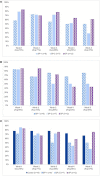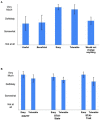Slow-Breathing Curriculum for Stress Reduction in High School Students: Lessons Learned From a Feasibility Pilot
- PMID: 36189008
- PMCID: PMC9397716
- DOI: 10.3389/fresc.2022.864079
Slow-Breathing Curriculum for Stress Reduction in High School Students: Lessons Learned From a Feasibility Pilot
Abstract
Purpose: Nearly one in three US adolescents meet the criteria for anxiety, an issue that has worsened with the COVID-19 pandemic. We developed a video-based slow diaphragmatic breathing stress-reduction curriculum for high school students and evaluated its feasibility, tolerability, and preliminary effectiveness.
Methods: This cluster-randomized feasibility pilot compared 5-min slow diaphragmatic breathing for 5 weeks with treatment-as-usual control among four 12th-grade public high school classes. Students individually participated after school during COVID-19-related hybrid teaching, with slow diaphragmatic breathing three times/week and breath science education once/week. Feasibility was based on completion of breathing exercises, breath science education, and preliminary effectiveness assessments, and ease/tolerability was based on qualitative assessments. Preliminary effectiveness was measured with the State-Trait Anxiety Inventory (STAI) and a timed-exhale carbon dioxide tolerance test (CO2TT) of physiological stress response. Descriptive statistics and repeated analysis of variance were performed to quantify and compare outcomes between time periods. Human subjects research approval was granted through Western IRB-Copernicus Group (WCG IRB) [ClinicalTrials.gov, Identifier: NCT05266833.].
Results: Forty-three students consented to participate. Breath practice compliance ranged from 29 to 83% across classes and weeks, and decreased on average over the 5 weeks. Compliance with the breath science videos ranged from 43 to 86%, and that with the weekly STAI-State and CO2TT measures varied from 36 to 86%. Compliance with ease/tolerability assessments ranged from 0 to 60%. Preliminary effectiveness assessments' compliance varied across classes from 83 to 89% during baseline, and 29 to 72% at follow-up. The curriculum was rated as somewhat-to-definitely useful/beneficial, and definitely-to-very easy/tolerable. Students reported enjoying the diaphragmatic breathing, CO2TT, and breath science education; some found the extended exhales challenging and the curriculum and assessments time-consuming. Preliminary effectiveness analyses indicated no significant changes in STAI or CO2TT from baseline to followup or from before to after breathing exercises (p > 0.05 for all).
Conclusions: Implementation of this 5-week slow breathing curriculum was feasible and tolerable to this cohort. Compliance, tolerability, and effectiveness may be improved with in-class participation. Future research on simple and accessible slow-breathing exercises is warranted to address today's adolescent stress-management crisis.
Trial registration: ClinicalTrials.gov, Identifier: NCT05266833.
Keywords: adolescents; diaphragmatic breathing; feasibility pilot; high school; stress reduction.
Copyright © 2022 Bentley, Seeber, Hightower, Mackenzie, Wilson, Velazquez, Cheng, Arce and Lorenz.
Conflict of interest statement
The authors declare that the research was conducted in the absence of any commercial or financial relationships that could be construed as a potential conflict of interest.
Figures



References
-
- Merikangas KR, He JP, Burstein M, Swanson SA, Avenevoli S, Cui L, Swendsen J., et al. . Lifetime prevalence of mental disorders in US adolescents: results from the National Comorbidity Survey Replication–Adolescent Supplement (NCS-A). J Am Acad Child Adolesc Psychiatry. (2010) 49:980–9. 10.1016/j.jaac.2010.05.017 - DOI - PMC - PubMed
-
- American Psychological Association, Stress in, America. (2014). Available online at: https://www.apa.org/news/press/releases/stress/2013/stress-report.pdf (accessed August 2020).
-
- American Academy of Child Adolescent Psychiatry. Stress management and teens. (2019). Available online at: https://www.aacap.org/AACAP/Families_and_Youth/Facts_for_Families/FFF-Gu... (accessed August 2020).
-
- Hussain A., Kumar A., Husain A. Academic stress and adjustment among high school students. J Indian Acad Appl Psychol. (2008) 34:70e73.
Associated data
LinkOut - more resources
Full Text Sources
Medical

